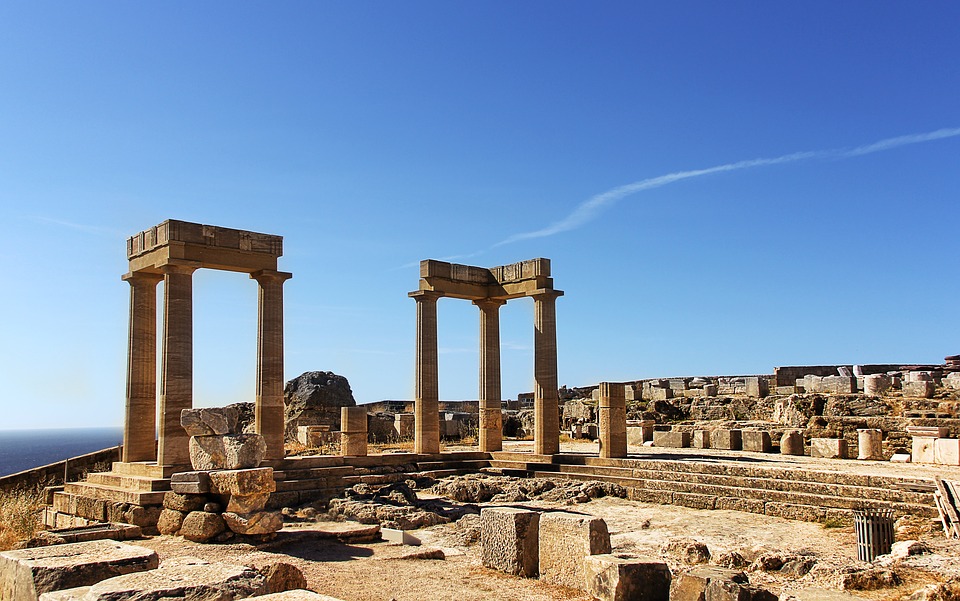Cinderella and Lesbianism – What do They Have in Common?
One of the great ancient Greek lyrists and few known female poets of the ancient world, Sappho, was included by Greeks in the canonical list of Nine Lyric Poets. She was called a lyrist because, as was the custom of the time, she wrote her poems to be performed with the accompaniment of a lyre. She was naturally gifted with a particular ability of seeing what many others could not see, of transforming feelings and emotions into verses. Everything in Sappho’s poetry is most definitely personal, deep, and insightful. Every single word is carefully chosen and weighted in order to convey a clear reflection of her inner soul. The bulk of her poetry, which was well-known and greatly admired throughout antiquity, has been lost, but her immense reputation has endured through surviving fragments.
Sappho was born into an aristocratic family in the town of Eresos on Lesbos during the 42nd Olympiad, some time between 630 and 612 BC. Sappho’s father’s name was Scamandronymus and her mother’s name was Cleis. Sappho had three brothers: Eurygius, Larichus and Charaxus. At the tender age of six her parents died and she became an orphan. In his Heroides, Ovid has Sappho lament that, “Six birthdays of mine had passed when the bones of my parent, gathered from the pyre, drank before their time my tears.” In 595 BC because of political activities against aristocracy, together with her brothers, she had to go into exile to Sicily and spent about 15 years there. By this time she was known as a poet, and the residents of Syracuse were so honored by her visit that they erected a statue to her.
Please (by Sapho) Come back to me, Gongyla, here tonight, You, my rose, with your Lydian lyre. There hovers forever around you delight: A beauty desired. Even your garment plunders my eyes. I am enchanted: I who once Complained to the Cyprus-born goddess, Whom I now beseech Never to let this lose me grace But rather bring you back to me: Amongst all mortal women the one I most wish to see. (Translated by Paul Roche)Tradition relates that she was not beautiful but “small and dark.” Sappho married a prosperous merchant named Cercylas, and had a daughter named Cleis, after her mother. Her happiness did not last long. Her husband and her beloved little girl passed away. Sappho devoted herself to poetry and music. Her wealth afforded her to live a luxurious life, and she chose to spend it studying and teaching the arts on the isle of Lesbos, which was a cultural center in seventh century BC. Sappho spent most of her time there in the town of Mytilene.
View of modern Mitilene
She had a school of music and poetry for young unmarried women. Sappho is depicted as teacher full of passion, leading a life full of freedom, luxury, and promiscuous sensuality. Sappho composed her own music and was one of the first poets to write from the first person, describing love and loss as it affected her personally instead of writing poetry from the point of view of gods and muses. Her style was sensual and melodic, and consisted primarily of songs of love. Plato elevated her from the status of great lyric poet to one of the muses. Upon hearing one of her songs, Solon, an Athenian ruler, lawyer, and a poet himself, asked that he be taught the song, “Because I want to learn it and die.” Socrates called her his mentor.
To Atthis (by Sapho) Though in Sardis now, she things of us constantly and of the life we shared. She saw you as a goddess and above all your dancing gave her deep joy. Now she shines among Lydian women like the rose-fingered moon rising after sundown, erasing all stars around her, and pouring light equally across the salt sea and over densely flowered fields lucent under dew. Her light spreads on roses and tender thyme and the blooming honey-lotus. Often while she wanders she remembers you, gentle Atthis, and desire eats away at her heart for us to come. (Translated by Willis Barnstone)Sappho’s poems usually focus on the relationships among women. This focus has given rise to speculation that Sappho’s interest in women was what today would be called homosexual or lesbian. (The word “lesbian” comes from the island of Lesbos and the communities of women there.) Sappho’s poetry was not condemned in her time for its homoerotic content, which suggests that perhaps love between women, whether sexual or not, was not persecuted then as it has been in more recent times.
Given the fame that her work has enjoyed, it is somewhat surprising to learn that only one of Sappho’s poems is available in its entirety – all of the rest exist as fragments of her original work. At one time, there were perhaps nine complete volumes of her poetry, but over the centuries, from neglect, natural disasters, and possibly some censorship by close-minded scholars, her work was lost. Late in the 19th century, however, manuscripts dating back to the eighth century AD were discovered in the Nile Valley, and some of these manuscripts proved to contain Sappho’s work.
Reflecting back on Sappho’s life story… Her brother, Charaxus, was trading as a merchant with Lesbian wine and went to the Egyptian town of Naucratis. He saw a girl of immense beauty named Rhodopis (the “rosy-cheeked”) and fell in love with her. Rhodopis was a fellow-slave with the poet Aesop, both of them belonging to the Samian Iadmon. She afterwards became the property of Xanthes, another Samian, who took her to Naucratis in Egypt, during the reign of Amasis II, where she continued to work as a hetaera for the benefit of her master. Charaxus ransomed her from slavery for a large sum of money and brought her to Mytilene. At first glance Sappho felt a passionate attraction to Rhodopis, but she was apparently cold and did not pay any attention to Sappho, making her terribly jealous of Charaxus. Endless arguments between sister and brother forced Charaxus to go back to Naucratis with the beauty. He hoped to be the only one for Rhodopis but destiny was not on his side. One day while Rhodopis was bathing in an Ormoc stream, an eagle took up one of her rose-gilded sandals, flew away with it, and dropped it in the lap of the Egyptian Pharaoh Amasis, as he was administering justice at Memphis. Struck by the strange occurrence, small size, and the beauty of the sandal, he asked the women of his kingdom to try on the sandal to see which one fits. Rhodopis succeeded and the Pharaoh made her his queen. This is the Rhodopis story, famed for being the earliest Cinderella story, the popular fairytale embodying a classic folk tale myth-element of unjust oppression and triumphant reward. Thousands of variants are known now throughout the world. The title character is a young woman living in unfortunate circumstances which suddenly change to remarkable fortune. The word “Cinderella” has, by analogy, come to mean one whose attributes are unrecognized, or one who unexpectedly achieves recognition or success after a period of obscurity and neglect.
Sappho, Phaon, and Cupid. Jacques-Louis David, 1809
Sappho lived to a fairly old age and died around 570 BC. The legend says that she killed herself by jumping off the Leucadian cliffs for love of Phaon, a young and handsome ferryman. This story may have resulted in part from a desire to assert Sappho as heterosexual.
From ancient times to today, Sappho has remained an important literary and cultural figure. Her works continue to be studied and translated, new poets are constantly inspired by her, and speculation on her life remains popular in the form of fictionalized tales and ardent research. For a woman who has been dead for over two thousand years, this is quite an achievement.
References:- www.sappho.com
- http://womenshistory.about.com/od/sappho/a/sappho.htm
- http://en.wikipedia.org/wiki/Sappho
- www.users.globalnet.co.uk/~loxias/sappho/sappho.pdf
- http://en.wikipedia.org/wiki/Cinderella
- http://en.wikipedia.org/wiki/Rhodopis_(hetaera)
- North, Alix. Isle of Lesbos: Poetry of Sappho, 2007

















